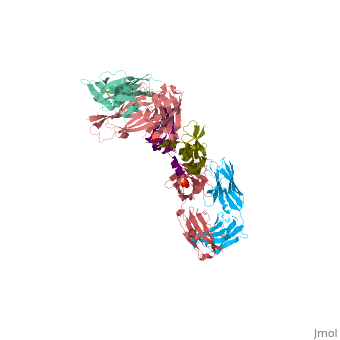1bj1
From Proteopedia
(Difference between revisions)
| Line 1: | Line 1: | ||
| - | + | ==VASCULAR ENDOTHELIAL GROWTH FACTOR IN COMPLEX WITH A NEUTRALIZING ANTIBODY== | |
| - | + | <StructureSection load='1bj1' size='340' side='right' caption='[[1bj1]], [[Resolution|resolution]] 2.40Å' scene=''> | |
| - | + | == Structural highlights == | |
| - | + | <table><tr><td colspan='2'>[[1bj1]] is a 6 chain structure with sequence from [http://en.wikipedia.org/wiki/Homo_sapiens Homo sapiens] and [http://en.wikipedia.org/wiki/Mus_musculus Mus musculus]. Full crystallographic information is available from [http://oca.weizmann.ac.il/oca-bin/ocashort?id=1BJ1 OCA]. For a <b>guided tour on the structure components</b> use [http://oca.weizmann.ac.il/oca-docs/fgij/fg.htm?mol=1BJ1 FirstGlance]. <br> | |
| - | ==Disease== | + | </td></tr><tr><td class="sblockLbl"><b>[[Ligand|Ligands:]]</b></td><td class="sblockDat"><scene name='pdbligand=SO4:SULFATE+ION'>SO4</scene><br> |
| + | <tr><td class="sblockLbl"><b>Resources:</b></td><td class="sblockDat"><span class='plainlinks'>[http://oca.weizmann.ac.il/oca-docs/fgij/fg.htm?mol=1bj1 FirstGlance], [http://oca.weizmann.ac.il/oca-bin/ocaids?id=1bj1 OCA], [http://www.rcsb.org/pdb/explore.do?structureId=1bj1 RCSB], [http://www.ebi.ac.uk/pdbsum/1bj1 PDBsum]</span></td></tr> | ||
| + | <table> | ||
| + | == Disease == | ||
[[http://www.uniprot.org/uniprot/VEGFA_HUMAN VEGFA_HUMAN]] Defects in VEGFA are a cause of susceptibility to microvascular complications of diabetes type 1 (MVCD1) [MIM:[http://omim.org/entry/603933 603933]]. These are pathological conditions that develop in numerous tissues and organs as a consequence of diabetes mellitus. They include diabetic retinopathy, diabetic nephropathy leading to end-stage renal disease, and diabetic neuropathy. Diabetic retinopathy remains the major cause of new-onset blindness among diabetic adults. It is characterized by vascular permeability and increased tissue ischemia and angiogenesis. | [[http://www.uniprot.org/uniprot/VEGFA_HUMAN VEGFA_HUMAN]] Defects in VEGFA are a cause of susceptibility to microvascular complications of diabetes type 1 (MVCD1) [MIM:[http://omim.org/entry/603933 603933]]. These are pathological conditions that develop in numerous tissues and organs as a consequence of diabetes mellitus. They include diabetic retinopathy, diabetic nephropathy leading to end-stage renal disease, and diabetic neuropathy. Diabetic retinopathy remains the major cause of new-onset blindness among diabetic adults. It is characterized by vascular permeability and increased tissue ischemia and angiogenesis. | ||
| + | == Function == | ||
| + | [[http://www.uniprot.org/uniprot/VEGFA_HUMAN VEGFA_HUMAN]] Growth factor active in angiogenesis, vasculogenesis and endothelial cell growth. Induces endothelial cell proliferation, promotes cell migration, inhibits apoptosis and induces permeabilization of blood vessels. Binds to the FLT1/VEGFR1 and KDR/VEGFR2 receptors, heparan sulfate and heparin. NRP1/Neuropilin-1 binds isoforms VEGF-165 and VEGF-145. Isoform VEGF165B binds to KDR but does not activate downstream signaling pathways, does not activate angiogenesis and inhibits tumor growth.<ref>PMID:11427521</ref> <ref>PMID:15520188</ref> <ref>PMID:16489009</ref> | ||
| + | == Evolutionary Conservation == | ||
| + | [[Image:Consurf_key_small.gif|200px|right]] | ||
| + | Check<jmol> | ||
| + | <jmolCheckbox> | ||
| + | <scriptWhenChecked>select protein; define ~consurf_to_do selected; consurf_initial_scene = true; script "/wiki/ConSurf/bj/1bj1_consurf.spt"</scriptWhenChecked> | ||
| + | <scriptWhenUnchecked>script /wiki/extensions/Proteopedia/spt/initialview01.spt</scriptWhenUnchecked> | ||
| + | <text>to colour the structure by Evolutionary Conservation</text> | ||
| + | </jmolCheckbox> | ||
| + | </jmol>, as determined by [http://consurfdb.tau.ac.il/ ConSurfDB]. You may read the [[Conservation%2C_Evolutionary|explanation]] of the method and the full data available from [http://bental.tau.ac.il/new_ConSurfDB/chain_selection.php?pdb_ID=2ata ConSurf]. | ||
| + | <div style="clear:both"></div> | ||
| + | <div style="background-color:#fffaf0;"> | ||
| + | == Publication Abstract from PubMed == | ||
| + | BACKGROUND: Vascular endothelial growth factor (VEGF) is a highly specific angiogenic growth factor; anti-angiogenic treatment through inhibition of receptor activation by VEGF might have important therapeutic applications in diseases such as diabetic retinopathy and cancer. A neutralizing anti-VEGF antibody shown to suppress tumor growth in an in vivo murine model has been used as the basis for production of a humanized version. RESULTS: We present the crystal structure of the complex between VEGF and the Fab fragment of this humanized antibody, as well as a comprehensive alanine-scanning analysis of the contact residues on both sides of the interface. Although the VEGF residues critical for antibody binding are distinct from those important for high-affinity receptor binding, they occupy a common region on VEGF, demonstrating that the neutralizing effect of antibody binding results from steric blocking of VEGF-receptor interactions. Of the residues buried in the VEGF-Fab interface, only a small number are critical for high-affinity binding; the essential VEGF residues interact with those of the Fab fragment, generating a remarkable functional complementarity at the interface. CONCLUSIONS: Our findings suggest that the character of antigen-antibody interfaces is similar to that of other protein-protein interfaces, such as ligand-receptor interactions; in the case of VEGF, the principal difference is that the residues essential for binding to the Fab fragment are concentrated in one continuous segment of polypeptide chain, whereas those essential for binding to the receptor are distributed over four different segments and span across the dimer interface. | ||
| - | + | VEGF and the Fab fragment of a humanized neutralizing antibody: crystal structure of the complex at 2.4 A resolution and mutational analysis of the interface.,Muller YA, Chen Y, Christinger HW, Li B, Cunningham BC, Lowman HB, de Vos AM Structure. 1998 Sep 15;6(9):1153-67. PMID:9753694<ref>PMID:9753694</ref> | |
| - | + | ||
| - | + | From MEDLINE®/PubMed®, a database of the U.S. National Library of Medicine.<br> | |
| - | + | </div> | |
==See Also== | ==See Also== | ||
*[[Monoclonal Antibody|Monoclonal Antibody]] | *[[Monoclonal Antibody|Monoclonal Antibody]] | ||
*[[Vascular Endothelial Growth Factor|Vascular Endothelial Growth Factor]] | *[[Vascular Endothelial Growth Factor|Vascular Endothelial Growth Factor]] | ||
| - | + | == References == | |
| - | == | + | <references/> |
| - | + | __TOC__ | |
| + | </StructureSection> | ||
[[Category: Homo sapiens]] | [[Category: Homo sapiens]] | ||
[[Category: Mus musculus]] | [[Category: Mus musculus]] | ||
Revision as of 17:39, 29 September 2014
VASCULAR ENDOTHELIAL GROWTH FACTOR IN COMPLEX WITH A NEUTRALIZING ANTIBODY
| |||||||||||


